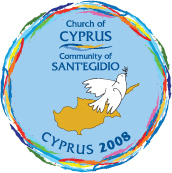
|
||||||||||
|
|
||||||||||
|
||||||||||||||||
|
||||||||||||||||
Cronologia
(tratta dal sito dell'UNFICYP)  L’isola di Cipro (Κύπρος o Kypros in greco, Kıbrıs in turco) si trova nel cuore del Mediterraneo orientale, di fronte alle coste della Palestina. L’isola di Cipro (Κύπρος o Kypros in greco, Kıbrıs in turco) si trova nel cuore del Mediterraneo orientale, di fronte alle coste della Palestina.In epoca apostolica fa parte dell’impero romano, poi dell’impero bizantino.
- Nel 1119 viene occupata dai Crociati e, fino al 1489, è governata dai re franchi. - Viene poi ceduta ai veneziani che ne fanno un centro commerciale strategico, per la sua posizione di fronte alla Palestina. Dal 1489 al 1571 Cipro è annessa alla Repubblica di Venezia. - Dal 1571 l'isola fa parte dell’Impero Ottomano, fino al 1878 quando è ceduta alla Gran Bretagna. - Nel 1923, con il Trattato di Losanna, Cipro diventa ufficialmente colonia britannica. - Nel 1946 il governo britannico annuncia l'intenzione di istituire un'assemblea consultiva che rediga una Costituzione per Cipro per avviarla all’indipendenza. - Si apre un periodo difficile per l’isola, denso di tensioni tra la maggioranza di etnia greca e la minoranza di etnia turca. Nel 1959 la Gran Bretagna concede l’indipendenza e il 16 agosto 1960 viene proclamata la Repubblica di Cipro. Il presidente è di etnia greca (l’arcivescovo Makarios), il vicepresidente di etnia turca (Fazil Küçük).
- Nel dicembre 1963 scoppia la violenza tra le due comunità etniche. - Il 4 marzo 1964 il Consiglio di Sicurezza dell’ONU adotta una risoluzione che stabilisce l’invio di un contingente internazionale per il mantenimento della pace nell’isola. - Nel luglio 1974 la Guardia Nazionale – a maggioranza greca - organizza un colpo di stato contro il governo di Cipro e quasi contemporaneamente la Turchia lancia una estesa operazione militare a Cipro.  Nell’agosto dello stesso anno viene proclamato il cessate il fuoco. L’isola è divisa in due parti. Nella capitale, Nicosia, un muro viene eretto per dividere la parte sud abitata dai greco ciprioti dalla parte nord abitata dai turco ciprioti. Nell’agosto dello stesso anno viene proclamato il cessate il fuoco. L’isola è divisa in due parti. Nella capitale, Nicosia, un muro viene eretto per dividere la parte sud abitata dai greco ciprioti dalla parte nord abitata dai turco ciprioti.- L’UNFICYP, la forza di pace dell’ONU, assume la responsabilità di controllare la linea di demarcazione (linea verde) che separa le due parti dell’isola.
- Nel novembre 1983 da parte turco cipriota viene proclamata la “Repubblica Turca di Nord Cipro” considerata invalida dal Consiglio di Sicurezza.
- Il 1 dicembre 2001 i capi delle comunità greco cipriota e turco cipriota raggiungono un accordo per riaprire i colloqui di pace.
- Il 23 aprile 2003 vengono aperti i punti di passaggio tra il nord e il sud.
- Il 24 aprile 2004 in tutta l’isola ha luogo un referendum su un piano delle Nazioni Unite (il “piano Annan”) per una sistemazione dell’isola. I turchi ciprioti votano in maggioranza a favore, mentre tra i greco ciprioti la maggioranza lo respinge.
- Il 1 maggio 2004 la repubblica di Cipro entra a far parte dell’Unione Europea come una isola divisa.
- Il 21 marzo 2008 dopo le lezioni il nuovo capo greco cipriota, Demetris Christofias, e il capo turco cipriota, Mehmet Ali Talat, si accordano per riprendere i negoziati e decidono l’apertura di un punto di comunicazione tra le due parti a Ledra Street, nel centro della capitale Nicosia.
- Il passaggio viene aperto il 3 aprile di quest’anno.
- Il 1 luglio 2008 i due capi politici raggiungono un accordo di principio sulle questioni relative alla sovranità e alla cittadinanza nella prospettiva di una Cipro unita. |
||||||||||||||||









